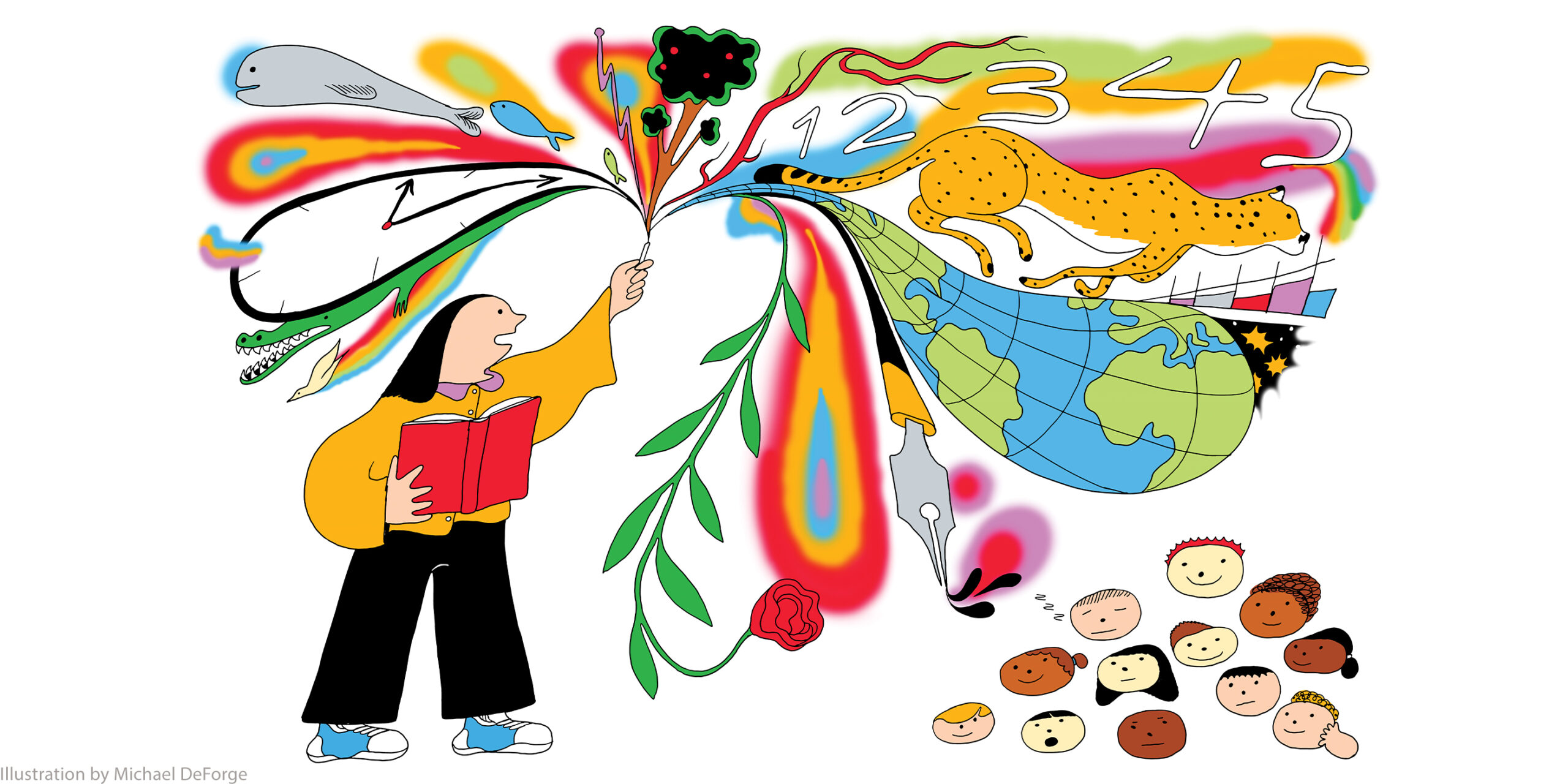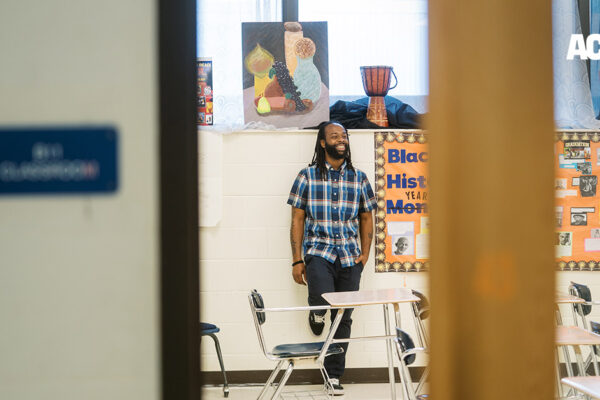When Anthony Crawford was in junior high school, he was kicked out of his AP History class one February after he asked the teacher when the class would learn about Black History Month.
“My question made the teacher uncomfortable. I remember his face turning red. He said, ‘You’re not going to disrupt my class, so please step out.’ So I tossed the books on the floor and left the class.”
Crawford never forgot the incident.
Two decades later, he proudly educates ninth graders about the very issues his teachers refused to teach him. At Millwood High School in Oklahoma City, he has crafted a curriculum that examines the systemic ways race and gender impact our lives.
When one walks into his classroom, the first thing they might notice is a colorful poster near the whiteboard with the words “Black History Year” spelled out in block letters. (“Month” had been crossed out and replaced.) Surrounding it are student projects about Nat Turner, Rosa Parks, the Black Panthers, and more.
“Most of the time, my students are the ones who want to talk about race and gender because these are the issues they deal with in their everyday lives,” Crawford told the ACLU last year. “It helps them make sense of what they witness when they step outside school. It also helps them understand themselves, their communities, and each other.”

Illustration by Michael DeForge
In addition to being a passionate educator, Crawford is also a plaintiff in a landmark lawsuit filed by the ACLU, the ACLU of Oklahoma, the Lawyers’ Committee for Civil Rights Under the Law, and pro bono counsel Schulte, Roth & Zabel: Black Emergency Response Team (BERT) v. O’Connor, which challenges a classroom censorship bill passed in Oklahoma, HB 1775.
Signed into law by Gov. Kevin Stitt in May 2021, the legislation restricts teachers and students alike from discussing race or gender in the classroom. Upon approving the bill, Stitt stated that “not one cent of taxpayer money should be used to define and divide young Oklahomans about their race or sex.”
Under the enforcement of this law, educators who violate it can lose their license to teach, and schools can even lose accreditation. The law’s broad language has been interpreted by educators and First Amendment experts as an attempt to deny historical facts, restrict academic freedom, and silence the experiences of marginalized groups. The effort to constrain free speech in the classroom reflects a broader movement by state legislators to restrict civil liberties across the board, including voting rights, LGBTQ equality, and gender equality.
“School officials specifically instructed us to avoid books by authors of color and women authors, leaving two books written by white men — The Great Gatsby by F. Scott Fitzgerald and The Crucible by Arthur Miller — as our only remaining anchor texts,” Regan Killackey told the ACLU last year. An English teacher at Edmond Memorial High School in Edmond, Oklahoma, Killackey is also a plaintiff in Bert v. O’Connor. His previous lesson plan had included works such as To Kill a Mockingbird and Their Eyes Were Watching God.
“[It] is detrimental to all my students. In essence, it prohibits me from doing my job,” said Killackey.
Critical Race Theory (CRT) is a scholarly framework developed by the late Derrick Bell, Kimberlé Crenshaw, Charles R. Lawrence III, Mari Matsuda, and others that examine the impact of race on our institutions and is commonly only taught at the graduate school level. It has become the latest obsession of conservative politicians who wish to put an abrupt stop to classroom conversations about race and exploit white voters’ fears in advance of the midterm elections. Though CRT, as such, is not typically taught in K–12 education, it has become a catch-all phrase that includes social-emotional learning, culturally responsive education, and anti-racism.
“Over the last few decades, we’ve had significant progress in making sure that curricula are more reflective of the diversity of students’ experiences and identities, and also present a more honest accounting of our history, the good, the bad, and the ugly,” says Emerson Sykes, senior staff attorney with the ACLU’s Speech, Privacy, and Technology Project.
“The education research is clear about the fact that inclusive education improves students’ understanding, improves their behavior, and even improves their academic performance.”
Sykes believes we’re now seeing a backlash to that improvement in school curricula and advancements in our national dialogue about race. The fight over CRT is where many white Americans are “pouring all of the racial anxieties that they have.”
In case you thought the architects of this Oklahoma bill were original in their thinking, parts of HB 1775 were copied verbatim from an executive order from President Donald Trump aimed at censoring government contractors in a similar way. The 2020 executive order was an attack on racial sensitivity training in the federal ranks, referring to these teachings as “divisive, un-American propaganda training sessions.”
Though the executive order was partially blocked on constitutional grounds and it was quickly withdrawn by President Biden, it still signaled to Trump’s base what type of legislation they could introduce at the local and state levels to achieve the desired chilling effect on educators. Trump’s executive order galvanized classroom censorship groups to mimic Trump’s bill with their own.
The summer of 2020 saw unprecedented, worldwide demonstrations for the Black Lives Matter movement after the murder of George Floyd by a Minnesota police officer. It was a centuries overdue moment of racial reckoning against our country’s history, and ugly truths that had been simmering just beneath the veneer of America’s status quo boiled over, spilling out into the streets for weeks on end.
“Racial justice messages were strewn everywhere. Even corporations were getting behind these ideas, and we felt like we were making some significant society-wide progress in our conversation about race. In the wake of that is when President Trump introduced the executive order,” says Sykes. “In many cases, including in Oklahoma, what we’ve seen is a direct copying and pasting from Trump’s executive order. Oftentimes, it’s tweaked. They add a provision or they subtract one to adapt to the local circumstances.”
Bills similar to HB 1775 featuring language that mirrors Trump’s executive order have been cropping up across the country, with 10 states and counting passing them into law. And there are more on the way: In 2022 alone, state legislatures introduced more than 111 new bills across 33 states, many of which explicitly targeted K-12 schools.
This flood of legislation echoes recent state efforts to enact laws that codify voter suppression and criminalize health care for transgender minors. This movement in the classroom may have the impression of a spontaneous grassroots coalition of concerned parents, but that’s not the case. As an investigative report from Education Week revealed, it’s the result of a very strategic and quickly moving assault on historically accurate education by well-resourced, interconnected conservative think tanks. “Impeccably organized” were the words a school district equity officer from the South used to describe the work of groups in their city.
A recent study from the UCLA Institute for Democracy, Education, and Access concluded that nearly 18 million students in public school, which is more than one-third of all K–12 students in the nation, have been affected by these classroom censorship efforts. The harm is incalculable.
From the UCLA study, one teacher anonymously shared that they have “avoided subjects I usually would’ve taught because I don’t want to be accused of indoctrinating … White students in my district have become empowered to deny white privilege and say that it is ‘reverse racism,’ [and people] completely dismiss voices from [people of color].”
Another worried teacher said in the survey that the legislation in their state has “taken away the ability to teach actual history and critical thought. They are taking away all nuance and deeper thought, stripping the subject of its actual value.… Students will not be able to effectively investigate the world around them.”
And even more important is the hostile learning environment this can create for students with marginalized identities.
Lilly Amechi, a plaintiff in BERT v. O’Connor, an undergraduate student at the University of Oklahoma, and a member of BERT, says, “To students of color, it sends a message that there is no willingness for people to understand our experiences. The reality is that race pervades the classroom even when it’s not the main subject.”
Sykes, who comes from a long line of teachers and educators, believes this spate of laws hurts students and attempts to take schools backward: “It’s trying to reinforce white supremacy for another generation.”
These bills aren’t going uncontested. The ACLU is mobilizing inside and outside of the courts to protect the First Amendment and academic freedom, as it has for more than a century. In addition to the ongoing Oklahoma lawsuit and a similar case in New Hampshire, in states like Idaho, ACLU affiliates are striving to educate teachers, students, parents, and activists about these forms of legislation and the rights that they possess.
In a violation of free speech, Idaho was one of the first states to introduce and pass an “anti-discrimination” measure that blocks teachers at schools and universities from discussing race or racism in class.
“They want a future where white folks dominate, continue to dominate, and are not made to feel badly about that,” says Aadika Singh, the legal director of the ACLU of Idaho. “Educators all throughout the state are really being pressed with this assumption that they are making white kids feel bad for having honest conversations and teaching the facts about race and gender.”
In Boise, Singh and other lawyers and researchers connected with more than 100 students and educators in the wake of increased classroom censorship and concluded that what the state needed was “education about education,” pivoting away from a typical litigation route. The ACLU of Idaho hosted trainings and workshops for educators and have focused their efforts on reducing the harm of the new law. They created a comprehensive toolkit around what was safe to teach in the classroom and the extent of educators’ academic freedom. An employment attorney was even brought in to advise teachers on what to do if they have to legally challenge a disciplinary action from school administrators.
“There’s this self-censorship where you have teachers saying, ‘I’m just not even a teacher anymore, I’m not going to teach this material because I might lose my job.’ It was very clear that people needed reassurance, needed confidence, and needed to be empowered,” adds Singh.
And at some universities like the University of Southern California in Los Angeles, educators are taking it a step further to expand rather than constrict dialogue. At the USC Gould School of Law, there’s a glimmer of a future where teachers and students are welcomed to think critically about themselves and the society they inhabit.
In 2021, Camille Gear Rich, the Dorothy Nelson Professor of Law and Sociology at the Gould School of Law, was a key advocate for a mandatory course for students that implores them to not only think about the history of bias and discrimination in the United States but also to understand the present-day impact of it within legal contexts. Rich and other faculty advocates were inspired to create the course after a culmination of Trump-era events in 2020, and their goal is to provide students, who may have different levels of exposure to America’s racial struggles, with a “foundational understanding of the facts.”
“Classroom censorship threatens to make the educational project in American schools incoherent. It undermines the ability to tell a logical story about the events of the United States,” she says. In what really feels like a fight for the future, she stresses the importance of learning from our past so that society doesn’t continue to repeat the same mistakes.
“Sometimes people worry that if their child learns about some of the shameful moments in America’s history, they will feel less proud of America or less connected to a patriotic outlook,” says Rich. “But it’s precisely the opposite. America is at its best when it takes into account the needs of all its people. That’s what gives students the motivation to feel a part of the American story and commit to making their own mark on that story.”
Sykes, who is African American, believes that all students have the right to learn an honest accounting of our country’s past and present and that efforts to wipe this out not only violate the First Amendment but run counter to the best interests of future generations.
“As a kid, I learned a whitewashed history,” he says. “The experiences of not seeing yourself reflected in your curriculum resonates deeply with me. The harm of that is something I continue to carry.”
Book Bans Get a New Chapter
Book bans may feel like a relic of a less enlightened past, but this practice has re-emerged with a vengeance. Last year, the American Library Association reported more than 700 challenges to various books in school libraries, with primarily authors of color and LGBTQ authors facing bans.
The Bluest Eye by Toni Morrison, Lawn Boy by Jonathan Evison, Heather Has Two Mommies by Lesléa Newman, and All Boys Aren’t Blue by George Johnson have all been targeted for exclusion in K–12 schools.
Earlier this year, the ACLU filed a lawsuit on behalf of students, parents, and local NAACP chapters challenging the Wentzville R-IV School District’s decision to remove some of the aforementioned books, as well as others discussing race and gender, from its libraries.
Students have a First Amendment right to access information in their school libraries. That includes Black, LGBTQ, and immigrant students having the ability to read books reflecting their own experiences, and the rights of all students to have access to viewpoints different from their own.
Support the right to learn by taking action at aclu.org/righttolearn.
This article originally appeared in the ACLU magazine. Join us today to receive the next issue. The article has been updated to include current data on classroom censorship legislation.


